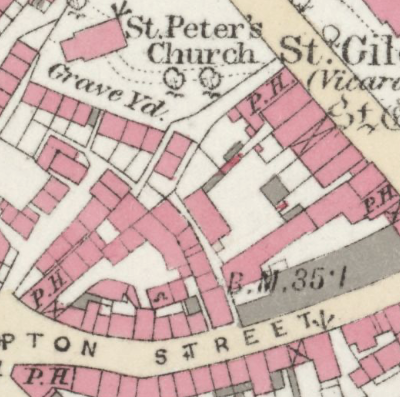Search by topic
- archaeology
- architecture
- bricklayer
- Building of Local Interest
- carpenter
- church
- crime
- dressmaker
- fire
- general labourer
- Great Eastern Railway
- listed building
- medieval
- oral history
- Public House
- Rattee & Kett
- Roman
- scholar
- school
- Then and Now
- tudor
- women
- work
- world war one
- world war two
Search by text
 St Giles' workhouse, Gentle's Yard 1911 (photo H P Stokes)(Cambridgeshire Collection)
St Giles' workhouse, Gentle's Yard 1911 (photo H P Stokes)(Cambridgeshire Collection)Gentle’s Yard, Northampton Street
History of Gentle's Yard, Northampton Street
Named after James Gentle, a landlord of the Borough Boy public house.
H P Stokes, Cambridge parish workhouses, 1911, on St St Giles’ workhouse: It consisted of six cottages, three in the front, later altered to a public house known as the Borough Boy, and three in a court at the rear with a large room where the paupers dined together. There is an old lady living near who has vividly described the condition of affairs just before the reforms; the men, women and children huddled together, and loafing in the court and streets; there was one man, mad and raving, ‘like a wild beast’, who lay on straw in a barred room. The open privies were not a pleasant feature of the situation. After the poor law reforms of 1836 the buildings were let to Mr Benjamin Clark for £20 a year, the tenants of the cottages in the streets being allowed the use of the pump and privy. The yard was sometimes called ‘Gentle’s Yard’ from the name of the chief tenant, a tradesman who was coffin make to the Mill Road Workhouse.
1867
James Gentle, beer retailer and wheel wright
1871
James Gentle, victualler and undertaker.
Adelaide
Elizabeth Arch, servant, b1871, b Balsham
1913
1. James Dellar, bricklayer
2. Thomas Bell, labourer
3. John Blackwell
1962
Gentle’s Yard – no residents
Contribute
Do you have any information about the people or places in this article? If so, then please let us know using the Contact page or by emailing capturingcambridge@
License
 This work is licensed under a Creative Commons Attribution-NonCommercial-ShareAlike 4.0 International License.
This work is licensed under a Creative Commons Attribution-NonCommercial-ShareAlike 4.0 International License.









